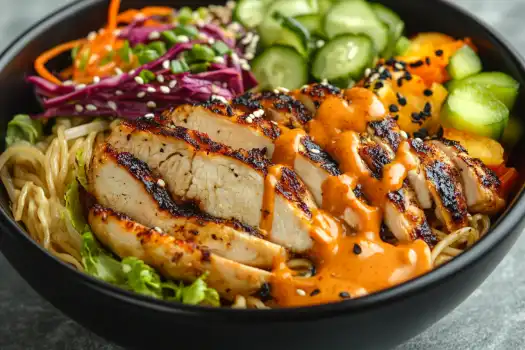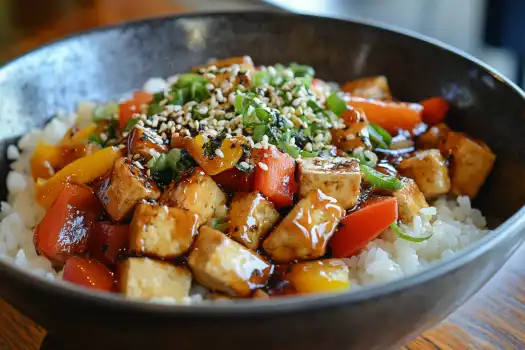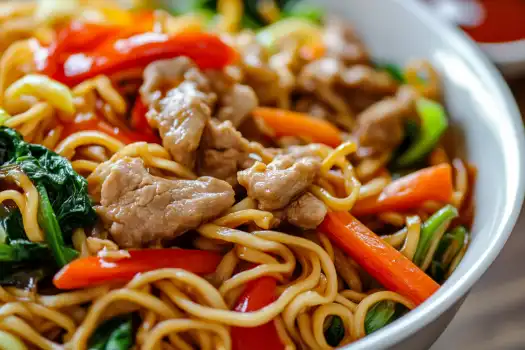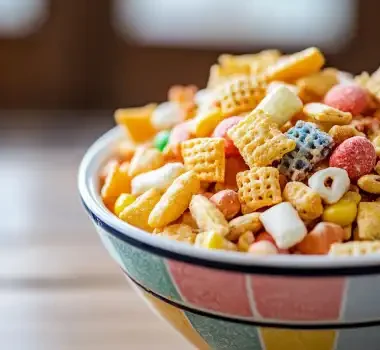Ever wondered, “What is in an Asia bowl?” This popular meal has gained massive attention for its vibrant flavors, versatility, and health benefits. Asia bowls, which are also known as Buddha bowls, are not just a trend; they are a celebration of diverse flavors and ingredients. In this extensive guide, we’re going to explore the essential components, various combinations, regional influences, and how you can create the ideal bowl for your taste. Whether you are looking for a quick lunch or a flavorful dinner, we will cover all aspects of this bowl. So, let’s uncover the delicious secrets of what is in an Asia bowl!
1. Understanding the Base: Grains and Noodles
1.1. Rice Options
Rice is a staple in many Asian cuisines and it is a commonly used base for Asia bowls. There are many different types of rice that you can use, such as white rice, brown rice, jasmine rice, or sticky rice. White rice is a classic choice, while brown rice offers more fiber and nutrients. Jasmine rice has a distinct floral aroma, and sticky rice has a unique texture that is perfect for certain dishes. The rice you choose will impact the texture and flavor of your bowl, so make sure you select the best option for your taste.
1.2. Noodle Varieties
Noodles are another popular base for Asia bowls, offering a wide array of textures and flavors. Some commonly used noodles are udon, soba, rice noodles, and ramen. Udon noodles are thick and chewy, while soba noodles are made from buckwheat and are much thinner. Rice noodles are light and versatile, while ramen noodles have a springy texture that is often used in many broths. Therefore, each type of noodle will bring its own unique characteristics to the bowl, so choose the one you prefer.
1.3. Grain Alternatives
Apart from rice and noodles, you can also explore other grain alternatives for your Asia bowl. Quinoa is a popular option as it is a protein-rich seed that cooks like a grain. Couscous is another good option because it is light and fluffy. These alternatives not only add diversity, but they also offer more nutritional value to your meal. This is very important if you want to have a balanced and healthy meal. When experimenting with your bowls, do not forget these delicious grains.
2. Adding Protein to Your Asia Bowl

2.1. Popular Protein Choices
The protein component is a key part of any Asia bowl, and you have many options to chose from. Some of the most popular choices are grilled or baked chicken, which offers lean protein; tofu, which is great for vegetarians; and succulent shrimp, which is rich in nutrients. The preparation method can vary; some are grilled, baked, or stir-fried. The way you chose to prepare your protein will change the texture and flavor of your bowl.
2.2. Plant-Based Protein
If you prefer a plant-based approach, there are many delicious vegetarian options to add to your Asia bowl. Tofu is a classic choice, as it is very versatile and can absorb flavors very well. Tempeh, made from fermented soybeans, has a firmer texture and offers additional nutrients. Edamame, or young soybeans, provide a great protein boost and are also delicious. These options are nutritious and offer a diverse range of flavors and textures.
2.3. Other Protein Options
In addition to the most popular protein options, you can incorporate others to add diversity to your Asia bowl. Fish, such as grilled salmon or tuna, is an excellent source of protein and healthy fats. Cooked eggs are also a great option, providing protein and other nutrients. These options will greatly enhance the nutritional value of your bowl and provide you with variety. So, do not forget to try these options to personalize your meal.
3. Vegetables: A Rainbow of Flavors and Nutrients
3.1. Leafy Greens
Leafy greens are a vital component of an Asia bowl, as they provide vitamins, minerals, and fiber. Spinach is a popular choice due to its mild flavor, while bok choy offers a slightly peppery taste and a crisp texture. Adding leafy greens not only enhances the nutritional value but also adds vibrant color to your dish. There are many options to chose from, so do not be afraid to experiment with different flavors.
3.2. Crunchy Vegetables
Adding crunchy vegetables to your Asia bowl will add different textures and a delicious flavor profile. Some popular options are carrots, which offer sweetness and crunch; cucumbers, which provide freshness; and bell peppers, which come in various colors and add a slightly sweet flavor. These vegetables will not only add taste, but also add a refreshing crunch to your bowl. This contrast of textures is important to achieve a balanced and delicious dish.
3.3. Other Vegetable Options
Beyond leafy greens and crunchy vegetables, you can include other nutritious vegetables in your Asia bowl. Broccoli florets are a great choice for adding a mild flavor and a bit of crunch. Edamame, which is both a protein and vegetable source, is another excellent option. These ingredients can enhance the nutritional value and overall flavor of your meal. When you are preparing your bowl, consider adding a diverse range of vegetables for best results.
4. The Importance of Sauces in an Asia Bowl
4.1. Common Sauces
Sauces are essential in any Asia bowl, as they tie all the ingredients together and add a burst of flavor. Some popular options are soy sauce, which provides umami; peanut sauce, which is creamy and nutty; and teriyaki sauce, which offers a sweet and savory taste. The sauce you choose will greatly impact the final taste of your bowl.
4.2. Spicy Sauce Options
For those who enjoy a bit of heat, there are many spicy sauce options to enhance your Asia bowl. Sriracha, which is made from chili peppers, offers a strong and tangy heat, while chili garlic sauce brings a savory and spicy kick. These sauces can help you add a more complex taste to your meal if you want to spice it up a bit. Always use them according to your preference and taste as you add it to avoid over-spicing your meal.
4.3. Healthy Sauce Choices
If you want to make your Asia bowl healthier, opt for lighter sauces with less sodium and sugar. You can use low-sodium soy sauce as a lighter alternative, and create your own peanut sauce with less added sugar. Additionally, you can use fresh lime juice as a light and tangy sauce. Using healthier sauces can greatly improve the nutritional profile of your meal.
5. Toppings and Garnishes: Adding the Final Touch

5.1. Crunchy Toppings
Adding crunchy toppings to your Asia bowl is crucial for adding texture and visual appeal to your dish. Sesame seeds provide a nutty flavor and a delicate crunch, while peanuts offer a richer and more substantial texture. You can also add fried onions for a savory and crispy addition. These crunchy toppings add a satisfying element to each bite, which helps create a more interesting experience.
5.2. Fresh Herbs
Fresh herbs are essential for adding aroma and freshness to your Asia bowl. Cilantro has a bright and citrusy flavor, while mint offers a refreshing taste. Basil is also a great option as it has a slightly sweet aroma and taste. Adding fresh herbs at the end not only enhances the overall flavor, but also adds a pop of vibrant color to the dish. The herbs are the final touch to make your dish simply amazing.
5.3. Other Topping Options
You can also incorporate other toppings to customize your Asia bowl to your liking. Lime wedges can add a touch of acidity, while pickled ginger can offer a sweet and tangy flavor. These additional options will elevate your dish and make it even more unique. When preparing your bowls, ensure that you incorporate all the toppings that you enjoy. This is a fantastic way to add your own personal touch.
6. Regional Variations of the Asia Bowl
6.1. Japanese-Inspired Bowls
Japanese-inspired Asia bowls often feature ingredients such as sushi rice, cooked fish (like salmon or tuna), seaweed salad, pickled ginger, and a variety of fresh vegetables. The sauces are often light and savory, such as soy sauce or a sesame dressing. These bowls emphasize fresh ingredients and a balance of flavors. The simplicity and elegance of the Japanese cuisine can be reflected in these type of bowls.
6.2. Chinese-Inspired Bowls
Chinese-inspired Asia bowls frequently use a base of rice or noodles, along with stir-fried vegetables, a protein such as chicken or tofu, and flavorful sauces like soy sauce, hoisin, or oyster sauce. You can also add ingredients like broccoli, bell peppers, carrots, and sesame seeds. These bowls highlight the stir-frying method and the vibrant flavors of Chinese cuisine. You can check out this article about bowl recipes for more ideas.
6.3. Thai-Inspired Bowls
Thai-inspired Asia bowls typically include a base of rice or rice noodles, along with a protein like shrimp or chicken, and a variety of fresh vegetables. These bowls often feature a creamy peanut sauce, a spicy red curry sauce or a sweet and sour sauce with herbs like cilantro and mint. The key is to balance all the flavor components. These types of bowls are known for their vibrant flavors.
6.4. Korean-Inspired Bowls
Korean-inspired Asia bowls usually feature a base of rice, along with ingredients like kimchi, bulgogi, and a variety of pickled vegetables. These bowls often include a spicy gochujang sauce and toppings such as sesame seeds or green onions. The combination of spicy and fermented flavors is typical of Korean cuisine. When exploring this option, make sure you are using your favorite korean components.
7. Tips for Creating Your Perfect Asia Bowl
7.1. Balancing Flavors and Textures
When you are creating your Asia bowl, it is very important to focus on achieving a balance of flavors and textures. You should incorporate a base of grains or noodles, a source of protein, a variety of vegetables, a flavorful sauce, and crunchy toppings. Having a balanced bowl will ensure that you have a fulfilling and nutritious meal that is not only tasty, but also satisfying. So, do not underestimate the importance of balancing all the flavor components.
7.2. Preparing Ingredients in Advance
If you want to have a quick meal, you should prep the ingredients for your Asia bowl in advance. You can cook the grains or noodles, chop the vegetables, prepare your protein, and mix your sauces ahead of time. This meal prep will save you a lot of time and ensure that you can assemble your bowls quickly when you are ready to eat. All the elements can be stored separately in the fridge and combined when you are ready to eat them.
7.3. Customizing to Your Preference
The beauty of an Asia bowl lies in its versatility and how easy it is to customize it to your own preferences. Do not be afraid to experiment with different ingredients, flavors, and combinations. You can swap in your favorite vegetables, try different protein sources, or mix up your sauces. The most important part is to have fun while cooking and create your ideal bowl.
8. FAQs About Asia Bowls
8.1. “What are the most common ingredients in an Asia bowl?”
The most common ingredients in an Asia bowl are rice or noodles, a protein source, such as chicken, tofu or shrimp, a variety of vegetables, a flavorful sauce, and some crunchy toppings. However, you can customize your bowl according to your liking. There are many variations that you can explore.
8.2. “Can I make an Asia bowl vegetarian or vegan?”
Yes, you can easily make an Asia bowl vegetarian or vegan. For a vegetarian option, you can add tofu, tempeh, or edamame as a source of protein. For a vegan option, make sure that your sauces do not contain any animal-derived products. The versatility of the Asia bowl makes it ideal for different dietary preferences.
8.3. “What kind of sauce should I use in an Asia bowl?”
The sauce you should use in an Asia bowl depends on your personal preference. You can chose a classic option like soy sauce, or a richer peanut sauce. For a spicy kick, use a sriracha sauce or a chili garlic option. The sauce is very important as it will greatly impact the final taste of the bowl.
8.4. “Are Asia bowls healthy?”
Yes, Asia bowls can be very healthy if they are made with the correct ingredients. When creating your bowl, ensure that you are using whole grains, lean protein, lots of vegetables, and healthy sauces. This will ensure that you have a well-balanced meal.
8.5. “How do I make sure my Asia bowl is balanced?”
To make sure that your Asia bowl is well-balanced, focus on including a good portion of grains or noodles, a source of protein, a variety of vegetables, a flavorful sauce and crunchy toppings. When you have all of these elements in a bowl, you will achieve a perfect balance that is both nutritious and delicious.
8.6. “Can I meal prep with Asia bowls?”
Yes, Asia bowls are a great option for meal prep. You can cook the grains or noodles, prepare your protein, chop your vegetables, and make your sauces ahead of time. Simply store them separately and assemble your bowls when you are ready to eat them. Meal prepping these types of bowls can save you time and effort during the week.
8.7. “What is the difference between an Asia bowl and a poke bowl?”
The difference between an Asia bowl and a poke bowl lies mainly in the origins and flavors. Asia bowls are a broad category that includes many different cuisines from Asia. They typically have cooked ingredients, and are served hot or warm. Poke bowls are typically Hawaiian in origin and usually contain raw fish, rice, and vegetables. Both options are nutritious and delicious, but they offer different flavor profiles.
Conclusion
What is in an Asia bowl? The answer is: a world of flavors, textures, and nutritious ingredients that you can combine according to your liking. From the base of grains or noodles, to the protein sources, vegetables, sauces, and toppings, each element has an important role in creating a balanced and satisfying meal. Whether you prefer a Japanese-inspired dish, a Thai variation, or your own unique version, the Asia bowl offers endless possibilities for a healthy and delicious meal. So, go ahead and create your own version of this dynamic dish!






